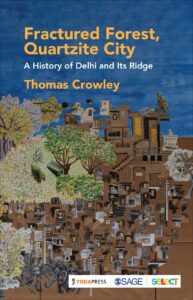Interviewed by Aarathi Ganesan; Edited by Nidhi Rejithlal.
There are history books written on pretty much everything in India–be it kings, kingdoms, cultures, or even food. Simply put: histories tell the tales of everything humans have interacted with and gotten up to.
So, given that, why is it that there are so few notable histories of our environment and ecology? After all, our ability to thrive and evolve in the Indian subcontinent depended on how we interacted with rivers, forests, fields, and stones to grow as societies.
So, what might the history of Indians look like, if told not through the lenses of this ruler or that empire, but rather, through the lenses of human-Nature interaction? That’s exactly what Thomas Crowley explores in SAGE and Yoda Press’s latest offering: Fractured Forest, Quartzite City. The book is the first history of one of Delhi’s most important ecological sites: the Ridge.
Spread over hundreds of acres, the Ridge’s hills and forests across time have shaped how the city of Delhi evolved and expanded over the years. In this three-part series with The Bastion’s Aarathi Ganesan, Crowley outlines why the history of the human-Nature interaction is important to understand amidst a climate crisis and growing climate activism.






